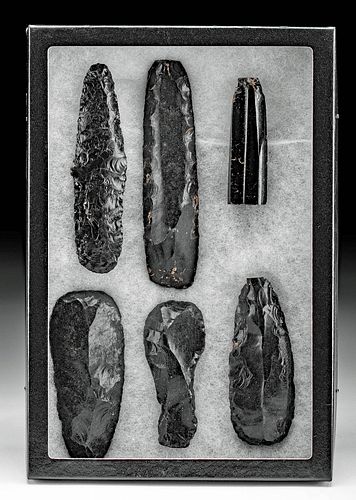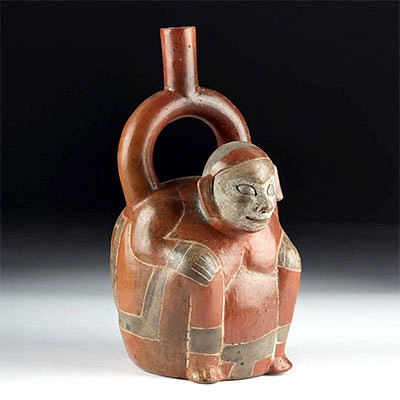Lot of 6 Colima Obsidian Tools & Core
Lot 189
About Seller
Artemis Gallery
686 S Taylor Ave, Ste 106
Louisville, CO 80027
United States
Selling antiquities, ancient and ethnographic art online since 1993, Artemis Gallery specializes in Classical Antiquities (Egyptian, Greek, Roman, Near Eastern), Asian, Pre-Columbian, African / Tribal / Oceanographic art. Our extensive inventory includes pottery, stone, metal, wood, glass and textil...Read more
Estimate:
$1,100 - $1,650
Absentee vs Live bid
Two ways to bid:
- Leave a max absentee bid and the platform will bid on your behalf up to your maximum bid during the live auction.
- Bid live during the auction and your bids will be submitted real-time to the auctioneer.
Bid Increments
| Price | Bid Increment |
|---|---|
| $0 | $25 |
| $300 | $50 |
| $1,000 | $100 |
| $2,000 | $250 |
| $5,000 | $500 |
| $10,000 | $1,000 |
| $20,000 | $2,500 |
| $50,000 | $5,000 |
| $100,000 | $10,000 |
| $200,000 | $20,000 |
About Auction
By Artemis Gallery
Jul 8, 2021
Set Reminder
2021-07-08 10:00:00
2021-07-08 10:00:00
America/New_York
Bidsquare
Bidsquare : CLEARANCE | Ancient & Ethnographic Art
https://www.bidsquare.com/auctions/artemis-gallery/clearance-ancient-ethnographic-art-7173
Kick off summer with our clearance sale featuring discounted pricing and many new items at superb prices! Asian art, Classical antiquities from Egypt, Greece, Italy, and the Near East...plus Pre-Columbian, Tribal, Russian Icons & Enamelware, Spanish Colonial, Fine Art, Fossils, more! Artemis Gallery info@artemisgallery.com
Kick off summer with our clearance sale featuring discounted pricing and many new items at superb prices! Asian art, Classical antiquities from Egypt, Greece, Italy, and the Near East...plus Pre-Columbian, Tribal, Russian Icons & Enamelware, Spanish Colonial, Fine Art, Fossils, more! Artemis Gallery info@artemisgallery.com
- Lot Description
**Originally Listed At $600**
Pre-Columbian, West Mexico, Colima, 300 BCE to 300 CE. A great collection of 6 obsidian stone tools intended for a variety of utilitarian or ritualistic purposes. The first is an elongated blade with random small flaking patterns on both faces which are slightly convex. The edges are serrated from knapping and taper to a rounded tip. The other four tools have one convex face with broad flaking strokes, and the other face is flat with a polished and highly reflective surface. The smallest item in the group is an obsidian core, with a cylindrical flat base and tip. The core was originally cone shaped, but the sides are fluted from creating individual razor-sharp blades. The blades were formed by applying pressure to the base of the core to flake off a part of the face, which created the fluted surface seen here. Obsidian was a hugely important resource in ancient Mesoamerica, traded far from its source in the volcanic zones of the Sierra Madre in Mexico and Guatemala. This is a nice collection that shows off the various uses and methods for creating obsidian tools. Size of largest tool: 6.25" L x 1.5" W (15.9 cm x 3.8 cm); case: 12.25" L x 2" W x 8.25" H (31.1 cm x 5.1 cm x 21 cm)
Obsidian - also known as "iztli" - fascinated the ancient Mesoamericans; the Aztecs even had a god, Tezcatlipoca, who was the Lord of the Smoking Obsidian Mirror. The shockingly sharp edges and point of this piece demonstrate its great allure. In a world without metal, this sharp quality was especially important for ceremonies of ritual bloodletting and human sacrifice. The difficult-to-obtain material came from volcanic sources in the Sierra Madre of Mexico and Guatemala, traded hundreds of miles to meet the demand for sharp cutting tools and ritual objects, and then were struck using a deer antler or small hammer stone to form blades and other shapes.
Provenance: private Fayetteville, Arkansas, USA collection; ex-Dr. David Harner collection, Springdale, Arkansas, USA, acquired between the 1950s and 1960s
All items legal to buy/sell under U.S. Statute covering cultural patrimony Code 2600, CHAPTER 14, and are guaranteed to be as described or your money back.
A Certificate of Authenticity will accompany all winning bids.
PLEASE NOTE: Due to recent increases of shipments being seized by Australian customs (even for items with pre-UNESCO provenance), we will no longer ship most Antiquities and ancient Chinese art to Australia. For categories of items that are acceptable to ship to Australia, please contact us directly or work with your local customs brokerage firm.
#162478Chips and nicks to all as expected with age and use. Forms are well preserved. Light mineral deposits. Displayed in Riker case.Condition
- Shipping Info
-
All shipping is handled in-house for your convenience. Your invoice from Artemis Gallery will include shipping calculation instructions. If in doubt, please inquire BEFORE bidding for estimated shipping costs for individual items.
-
- Buyer's Premium



 EUR
EUR CAD
CAD AUD
AUD GBP
GBP MXN
MXN HKD
HKD CNY
CNY MYR
MYR SEK
SEK SGD
SGD CHF
CHF THB
THB













